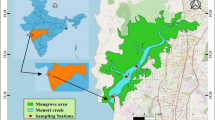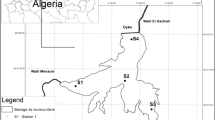Abstract
Analysis of aquatic ecosystem data collected from large water bodies must consider spatial variations. A suite of pelagic survey stations exists for the Laurentian Great Lakes, but little is known about their redundancy. We present a strategy to delineate the lakes into zones based on water quality and phytoplankton biovolume. Water samples were collected from 72 sites in two seasons (spring and summer) from 2007 to 2010 in all five lakes. Integrated samples were analyzed for phytoplankton biovolume and nine water quality parameters. We conducted cluster analysis, principal components analysis and non-metric multidimensional scaling methods for water quality and phytoplankton taxon-specific biovolume for the Great Lakes basin and for each lake separately. There were significant lake-to-lake differences, and based on lake-specific analyses, Lake Superior, Lake Michigan and Lake Erie were each divided into three zones; Lake Huron and Lake Ontario were each grouped into two zones. The zones identified by water quality and phytoplankton provide an understanding of spatial distributions for evaluating monitoring data.






Similar content being viewed by others
References
Allan JD, McIntyre PB, Smith SDP, Halpern BS, Boyer G, Buchsbaum A, Burton A, Campbell L, Chadderton L, Ciborowski J, Doran P, Eder T, Infante DM, Johnson LB, Joseph CG, Marino AL, Prusevich A, Read J, Rose J, Rutherford E, Sowa S, Steinman AD (2013) Joint analysis of stressors and ecosystems services to enhance restoration effectiveness. Proc Natl Acad Sci 110:372–377
Allinger LE, Reavie ED (2013) The ecological history of Lake Erie as recorded by the phytoplankton community. J Great Lakes Res 39:365–382
Andersen JH, Aigars J, Claussen U, Håkansson B, Karup H, Laamanen M, Lysiak-Pastuszak E, Martin G, Nausch G (2006) Development of tools for assessment of eutrophication in the Baltic Sea. In: Baltic Sea Environment Proceedings 104, Helsinki Commission (HELCOM), Baltic Marine Environment Protection Commission
APHA (American Public Health Association) (1985) Standard method for the examination of water and waste water, 16th edn. American Public Health Association, Washington
Auer MT, Tomlinson LM, Higgins SN, Malkin SY, Howell ET, Bootsma HA (2010) Great Lakes Cladophora in the 21st century: same algae—different ecosystem. J Great Lakes Res 36:248–255
Austin JA, Colman SM (2008) A century of temperature variability in Lake Superior. Limnol Oceanogr 53:2724–2730
Barbiero RP, Tuchman ML (2001) Results from the US EPA’s biological open water surveillance program of the Laurentian Great Lakes: I. Introduction and phytoplankton results. J Great Lakes Res 27:134–154
Barbiero RP, Tuchman ML, Warren GJ, Rockwell DC (2002) Evidence of recovery from phosphorus enrichment in Lake Michigan. Can J Fish Aquat Sci 59:1639–1647
Barbiero RP, Lesht BM, Warren GJ (2011) Evidence for bottom-up control of recent shifts in the pelagic food web of Lake Huron. J Great Lakes Res 37:78–85
Barbiero RP, Lesht BM, Warren GJ (2012) Convergence of trophic state and the lower food web in Lakes Huron, Michigan and Superior. J Great Lakes Res 38:368–380
Bennington V, McKinley GA, Kimura N, Wu CH (2010) General circulation of Lake Superior: mean, variability, and trends from 1979 to 2006. J Geophys Res 115:C12015
Carrick HJ (2004) Algal distribution patterns in Lake Erie: implications for oxygen balances in the eastern basin. J Great Lakes Res 30:133–147
Carrick HJ, Barbiero RP, Tuchman M (2001) Variation in Lake Michigan plankton: temporal, spatial, and historical trends. J Great Lakes Res 27:467–485
Chapra SC, Dolan DM (2012) Great Lakes total phosphorus revisited: 2. Mass balance modeling. J Great Lakes Res 38:741–754
Chapra SC, Dove A, Warren GJ (2012) Long-term trends of Great Lakes major ion chemistry. J Great Lakes Res 38:550–560
Dolan DM, Chapra SC (2012) Great Lakes total phosphorus revisited: 1. Loading analyses and update (1991–2008). J Great Lakes Res 38:730–740
Dolan DM, McGunagle KP (2005) Lake Erie total phosphorus loading analysis and update: 1996–2002. J Great Lakes Res 31:11–22
Dove A (2009) Long-term trends in major ion and nutrients in Lake Ontario. Aquat Ecosys Health Manag 12:281–295
El-Shaarawi AH, Kwiatkowski RE (1977) A model to describe the inherent spatial and temporal variability of parameters in Lake Ontario 1974. J Great Lakes Res 3:177–183
Evans MA, Fahnenstiel G, Scavia D (2011) Incidental oligotrophication of North American Great Lakes. Environ Sci Technol 45:3297–3303
Ghadouani A, Smith REH (2005) Phytoplankton distribution in Lake Erie as assessed by a new in situ spectroflurorometric technique. J Great Lakes Res 31:154–167
GLNPO (Great Lakes National Program Office) (2010) Sampling and analytical procedures for GLNPO’s open lake water quality survey of the Great Lakes. Prepared by the US Environmental Protection Agency. Great Lakes National Program Office, Chicago IL. EPA 905-R-05-001, March 2010. https://www3.epa.gov/greatlakes/monitoring/sop/index.html. Cited 29 Feb 2016
Helsel DR, Hirsch RM (2002) Statistical Methods in Water Resources. In: Techniques of water-resources investigations of the United States Geological Survey, book 4, hydrologic analysis and interpretation. US Geological Survey. http://pubs.usgs.gov/twri/twri4a3/pdf/twri4a3-new.pdf. Cited 29 Feb 2016
Holcombe TL, Taylor LA, Reid DF, Warren JS, Vincent PA, Herdendorf CE (2003) Revised Lake Erie postglacial lake level history based on new detailed bathymetry. J Great Lakes Res 29:681–704
Holeck KT, Watkins JM, Mills EL, Johannsson O, Millard S, Richardson V, Bowen K (2008) Spatial and long-term temporal assessment of Lake Ontario water clarity, nutrients, chlorophyll, and zooplankton. Aquat Ecosys Health Manag 11:377–391
Host GE, Brown TN, Hollenhorst TP, Johnson LB, Ciborowski JJH (2011) High-resolution assessment and visualization of environmental stressors in the Lake Superior basin. Aquat Ecosys Health Manag 14:376–385
Kaur J, DePinto JV, Atkinson JF, Verhammer E, Young TC (2012) Development of a spatially resolved linked hydrodynamic and exposure model (LOTOX2) for PCBs in Lake Ontario. J Great Lakes Res 38:490–503
Kovalenko KE, Reavie ED, Allan JD, Cai M, Smith SDP, Johnson LB (2017) Pelagic phytoplankton community change-points across nutrient gradients and in response to invasive mussels. Freshwater Biol 62:366–381
Kwiatkowski RE (1982) Trends in Lake Ontario surveillance parameters, 1974–1980. J Great Lakes Res 8:648–659
Leon LF, Smith REH, Hipsey MR, Bocaniov SA, Higgins SN, Hecky RE, Antenucci JP, Imberger JA, Guildford SJ (2011) Application of a 3D hydrodynamic-biological model for seasonal and spatial dynamics of water quality and phytoplankton in Lake Erie. J Great Lakes Res 37:41–53
Madenjian CP, Pothoven SA, Schneeberger PJ, Ebener MP, Mohr LC, Nalepa TF, Bence JR (2010) Dreissenid mussels are not a “dead end” in Great Lakes food webs. J Great Lakes Res 36:73–77
Makarewicz JC, Lewis TW, Bertram P (1999) Phytoplankton composition and biomass in the offshore waters of Lake Erie: pre- and post-Dreissena introduction (1983–1993). J Great Lakes Res 25:135–148
Makarewicz JC, Lewis TW, Boyer GL, Edwards WJ (2012) The influence of streams on nearshore water chemistry, Lake Ontario. J Great Lakes Res 38:62–71
Michalak AM, Anderson EJ, Beletsky D, Boland S, Bosch NS, Bridgeman TB, Chaffin JD, Cho K, Confesor R, Daloglu I, DePinto JV, Evans MA, Fahnenstiel GL, He L, Ho JC, Jenkins L, Johengen TH, Kuo KC, LaPorte E, Liu X, McWilliams MR, Moore MR, Posselt DJ, Richards RP, Scavia D, Steiner AL, Verhamme E, Wright DM, Zagorski MA (2013) Record-setting algal bloom in Lake Erie caused by agricultural and meteorological trends consistent with expected future conditions. Proc Natl Acad Sci USA 110:6448–6452
Mida JL, Scavia D, Fahnenstiel GL, Pothoven SA, Vanderploeg HA, Dolan DM (2010) Long-term and recent changes in southern Lake Michigan water quality with implications for present trophic status. J Great Lakes Res 36:42–49
Millie DF, Fahnenstiel GL, Bressie JD, Pigg RJ, Rediske RR, Klarer DM, Tester PA, Litaker RW (2009) Late-summer phytoplankton in western Lake Erie (Laurentian Great Lakes): bloom distributions, toxicity, and environmental influences. Aquat Ecol 43:915–934
Niemi GJ, Kelly JR, Danz NP (2007) Environmental indicators for the coastal region of the North American Great Lakes: introduction and prospectus. J Great Lakes Res 33:1–12
Nõges P, Tuvikene L (2012) Spatial and annual variability of environmental and phytoplankton indicators in Lake Vortsjarv: implications for water quality monitoring. Eston J Ecol 61:227–246
Oksanen J, Blanchet FG, Kindt R, Legendre P, Minchin PR, O’Hara RB, Simpson GL, Solymos P, Stevens MHH, Wagner H (2016) Vegan: community ecology package. R package version 2.3-4. https://cran.r-project.org/web/packages/vegan/vegan.pdf. Cited on 26 Feb 2016
Reavie ED, Allinger LE (2011) What have diatoms revealed about the ecological history of Lake Superior? Aquat Ecosys Health Manag 14:396–402
Reavie ED, Barbiero RP (2013) Recent changes in abundance and cell size of pelagic diatoms in the North American Great Lakes. Phytotaxa 127:150–162
Reavie ED, Axler RP, Sgro GV, Danz NP, Kingston JC, Kireta AR, Brown TN, Hollenhorst TP, Ferguson MJ (2006) Diatom-based weighted-averaging transfer functions for Great Lakes coastal water quality: relationships to watershed characteristics. J Great Lakes Res 32:321–347
Reavie ED, Jicha TM, Angradi TE, Bolgrien DW, Hill BH (2010) Algal assemblages for large river monitoring: comparison among biovolume, absolute and relative abundance metrics. Ecol Indic 10:167–177
Reavie ED, Barbiero RP, Allinger L, Warren G (2014) Phytoplankton trends in the Great Lakes, 2001–2011. J Great Lakes Res 40:618–639
Reavie ED, Sgro GV, Estepp LR, Bramburger AJ, Pillsbury RW, Shaw Chraïbi VL, Cai M, Stow CA, Dove A (2017) Climate warming and changes in Cyclotella sensu lato in the Laurentian Great Lakes. Limnol Oceanogr 62:768–783
Rygwelski KR, Zhang X, Kreis RG Jr (2012) Model forecasts of atrazine in Lake Michigan in response to various sensitivity and potential management scenarios. J Great Lakes Res 38:1–10
Stoermer EF (1978) Phytoplankton assemblages as indicators of water quality in the Laurentian Great Lakes. Trans Am Microsc Soc 97:2–16
Stumpf RP, Wynne TT, Baker DB, Fahnenstiel GL (2012) Interannual variability of cyanobacterial blooms in Lake Erie. PLoS One 7:1–11
R Core Team (2013) R: a language and environment for statistical computing. R Foundation for Statistical Computing, Vienna, Austria. version 2.15. Available from: http://www.R-project.org. Cited on 29 Sept 2014
Vanderploeg HA, Liebig JR, Nalepa TF, Fahnenstiel GL, Pothoven SA (2010) Dreissena and the disappearance of the spring phytoplankton bloom in Lake Michigan. J Great Lakes Res 36:50–59
Welschmeyer N (1994) Fluorometric analysis of chlorophyll a in the presence of chlorophyll b and pheopigments. Limnol Oceanogr 39:1985–1992
Wynne TT, Stumpf RP, Tomlinson MC, Dyble J (2010) Characterizing a cyanobacterial bloom in western Lake Erie using satellite imagery and meteorological data. Limnol Oceanogr 55:2025–2036
Acknowledgements
We thank Kitty Kennedy, Amy Kireta, Lisa Estepp and the Research Vessel Lake Guardian field crews for their work collecting phytoplankton samples and Michael Agbeti for supporting analyses of phytoplankton samples. This research was supported by a Grant to E. Reavie from the US Environmental Protection Agency under Cooperative Agreement GL-00E23101-2. This document has not been subjected to the EPA’s required peer and policy review and therefore does not necessarily reflect the view of the Agency, and no official endorsement should be inferred. This is contribution number 581 of the Center for Water and the Environment, Natural Resources Research Institute, University of Minnesota Duluth.
Author information
Authors and Affiliations
Corresponding author
Ethics declarations
Ethical standards
The analyses conducted comply with the current laws of USA.
Conflict of interest
The authors have no financial relationship with the organizations that sponsored the research. The authors have full control of all primary data and agree to allow the journal to review the data if requested.
Additional information
Handling Editor: Toshiya Katano.
Electronic supplementary material
Below is the link to the electronic supplementary material.
Rights and permissions
About this article
Cite this article
Cai, M., Reavie, E.D. Pelagic zonation of water quality and phytoplankton in the Great Lakes. Limnology 19, 127–140 (2018). https://doi.org/10.1007/s10201-017-0526-y
Received:
Accepted:
Published:
Issue Date:
DOI: https://doi.org/10.1007/s10201-017-0526-y




